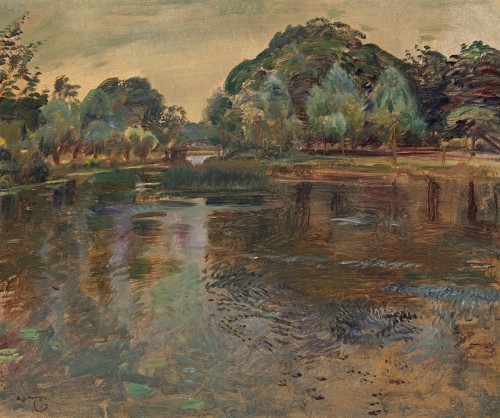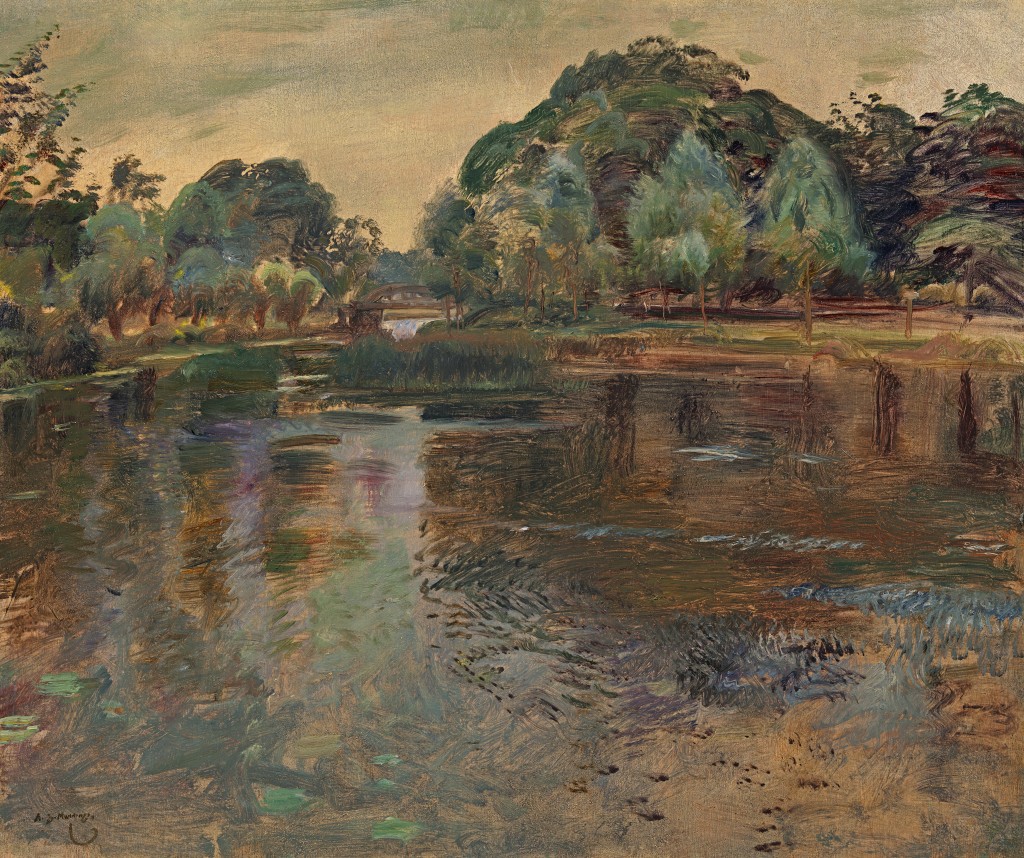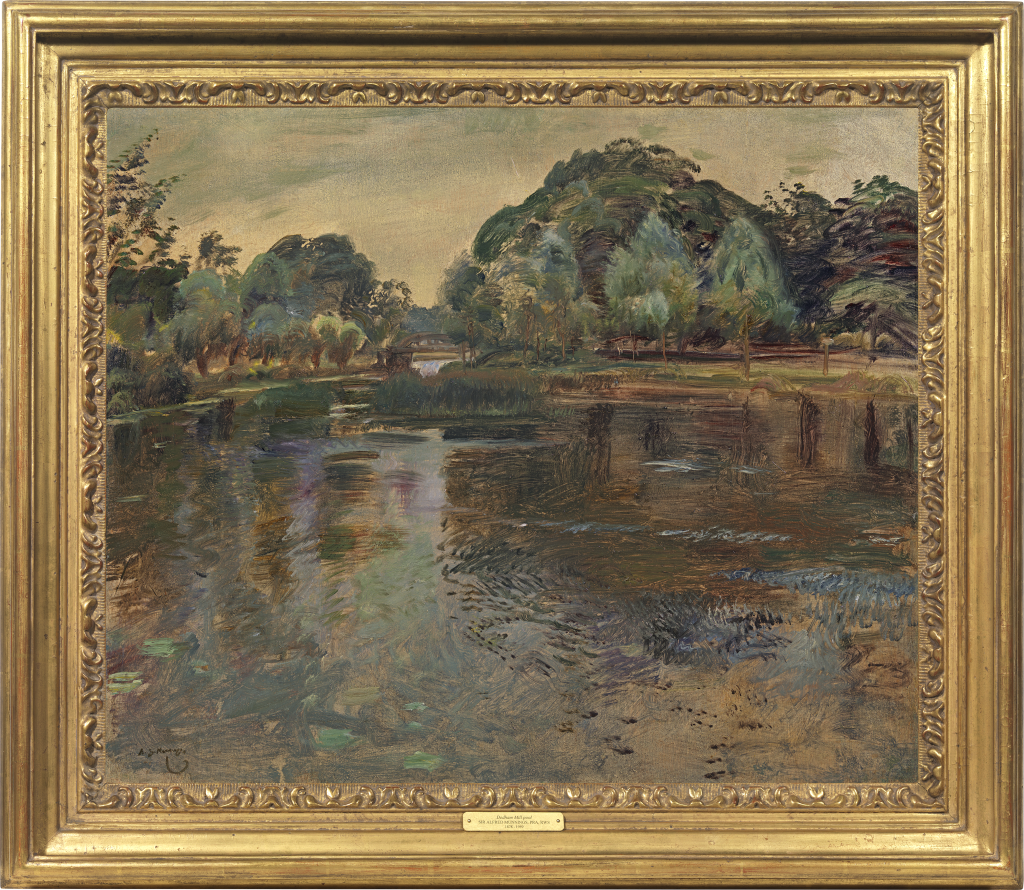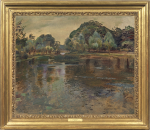SIR ALFRED MUNNINGS
Mendham 1878 - 1959 Dedham
Ref: BZ 131
Dedham Mill pool
Signed lower left: A.J.Munnings
Oil on panel: 20 x 24 in / 50.8 x 61 cm
Frame size: 26 x 30 in / 66 x 76.2 cm
Painted circa 1935
Provenance:
Leggatt Brothers, London;
EP Taylor (1901-1989), Toronto, acquired from the above before 1955
Private collection, Ohio, USA
Alfred Munnings bought Castle House, Dedham on the Essex-Suffolk border in 1919 and lived there until his death in 1959. Although he built his fame and fortune on equestrian subjects and equestrian portraits, like the portraitist Thomas Gainsborough (1727-1788), a fellow Suffolk man, he was ambivalent about the genre by which he made his living, finding his deepest happiness painting nature along the beautiful valley of the Stour.
This painting shows the pond at Dedham Mill, about three-quarters of a mile from Castle House, looking towards the bridge that carries Mill Lane from Dedham towards Stratford St Mary. It was built in 1900 and replaced by the current bridge in 1974. Screened by the trees, up on the hill to the east, is Constable’s birthplace, East Bergholt. Munnings could not escape his illustrious predecessor when painting this subtle millpond view, as Constable’s father had managed the mill and Constable worked there as a young man. One of Constable’s most famous compositions is his 1820 view of Dedham lock and mill (Victoria & Albert Museum, London), which shows the mill, lock and Dedham church tower from across the pond[1].
Munnings’s viewpoint is taken from the lock gates, with the mill (much enlarged in the later nineteenth century and now converted into flats) out of sight on the right. The sweep of the calm pond fills two-thirds of the composition. Munnings paints the pond with great subtlety, describing the ripples in the foreground and the blue, purple and green reflections. Sunlight haloes the pollarded willows on the left bank. Munnings’s handling of water owes a debt to Impressionism, particularly Monet’s Waterlilies series, but his understanding of the structure of the different types of trees and the way different leaves reflect the light is impelled by his acute, countryman’s eye. Munnings, like Constable, was a miller’s son imbued from childhood with a sense of the importance of nature’s shifting moods and a fascination with ponds, rivers and weed-winding banks. The Stour Valley, an Area of Outstanding Natural Beauty, is sympathetically managed and Munnings’s viewpoint is little changed today.
The 1900 iron bridge across the Stour at Dedham. Postcard from the collection of the Dedham Village Association.
John Constable, Dedham lock and mill, signed and dated 1820. Victoria and Albert Museum, London.
We are grateful to Lucy Archer for kindly providing information about Dedham bridge and to the Dedham Village Association for permission to reproduce the postcard. SIR ALFRED MUNNINGS, PRA, RWS
Mendham 1878 - 1959 Dedham
Born in Mendham, Suffolk, Alfred Munnings was the son of a miller. He was apprenticed to a firm of lithographers from 1893 to 1898 and studied at the Norwich School of Art and in Paris. There he was impressed with plein-air naturalism; this, together with his introduction to the racecourse in 1899, influenced the themes for which he became famous.
While in Mendham, Munnings painted many scenes of country life, particularly horse fairs. He went to Cornwall in 1908, and for many years was an important addition to the Newlyn School of artists. When the First World War broke out, Munnings enlisted, despite having the use of only one eye owing to an accident in 1899. He became an army horse trainer near Reading and later went to France as an official war artist, attached to the Canadian Cavalry Brigade.
The year 1919 was a major turning-point in all aspects of Munnings’s life; he painted his first racehorse, Pothlyn, the winner of the Grand National, and became an Associate of the Royal Academy. He met Violet McBride, whom he was to marry, and bought Castle House, Dedham, where the Munnings Memorial Trust maintains a permanent exhibition of his pictures. Munnings’s prolific career, spanning over sixty years, brought him honour, with election to the Presidency of the Royal Academy in 1944, a Knighthood in 1945, and a personal award from the Sovereign in 1947, when he was created Knight of the Royal Victorian Order.
[1] Canvas 21 1/8 x 30 in / 53.7 x 76.2 cm. See Graham Reynolds, The Later Paintings and Drawings of John Constable, New Haven and London 1984; Text vol. p.47, no.20.10; Plates vol. plate 137, illus. in colour. Unusually, Constable made several versions of this view.



























